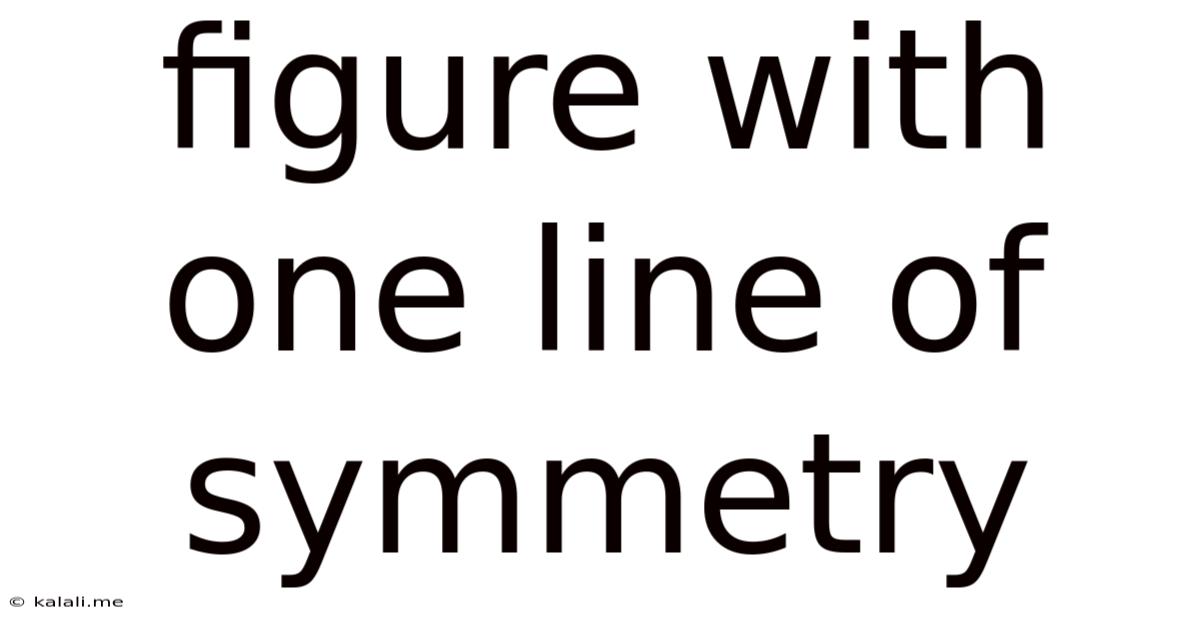Figure With One Line Of Symmetry
Kalali
Jun 13, 2025 · 3 min read

Table of Contents
Figures with One Line of Symmetry: A Comprehensive Guide
A figure with one line of symmetry, also known as a bilaterally symmetrical figure, is a shape that can be folded in half along a single line, creating two perfectly matching halves. This line is called the line of symmetry or axis of symmetry. Understanding line symmetry is fundamental in geometry, art, and design. This article will delve into the characteristics, examples, and identification of figures possessing this unique property.
Understanding the concept of one line of symmetry is crucial for grasping various geometric principles. We'll explore different shapes and how to determine if they exhibit this type of symmetry. Learning to identify these figures is essential for various applications, from designing logos to understanding the properties of different geometric shapes.
Identifying Figures with One Line of Symmetry
The key to identifying a figure with one line of symmetry is its ability to be folded along a single line such that the two halves perfectly overlap. Imagine folding a piece of paper in half. If the two halves match exactly, the fold line is a line of symmetry. Let's explore some examples:
-
Isosceles Triangles: An isosceles triangle, which has two sides of equal length, has one line of symmetry. This line passes through the vertex opposite the unequal side and bisects the base.
-
Rectangles: A rectangle, with opposite sides equal in length, has one line of symmetry if it is not a square. This line runs through the midpoints of the opposite sides.
-
Regular Pentagons (and other polygons): While regular polygons like pentagons may possess multiple lines of symmetry, a figure that is a slightly irregular pentagon will only have one, provided it has only one line of reflective symmetry.
-
Many Letters of the Alphabet: Letters like A, B, C, D, E, K, M, T, U, V, W, and Y all possess one line of symmetry. Consider carefully how to fold each letter to see where the single line of symmetry would be.
-
Human Faces (Approximately): While not perfectly symmetrical, human faces exhibit approximate bilateral symmetry, with a single line of symmetry generally running down the middle of the face. This approximate symmetry is often considered an aspect of beauty.
Distinguishing One Line of Symmetry from Multiple Lines
It's crucial to differentiate figures with one line of symmetry from those with multiple lines or no lines of symmetry. A square, for example, has four lines of symmetry, while a scalene triangle (with all sides of different lengths) has none. A circle boasts infinite lines of symmetry.
Understanding this difference is vital when analyzing geometric shapes and their properties. The number of lines of symmetry can be a defining characteristic for classifying different geometric shapes.
Real-World Applications of One Line of Symmetry
The concept of one line of symmetry is widely used in various fields:
-
Art and Design: Artists and designers utilize line symmetry to create visually appealing and balanced compositions. Logos, patterns, and architectural designs often incorporate this principle.
-
Nature: Many natural objects, including leaves, insects, and some flowers, exhibit bilateral symmetry. This is a reflection of fundamental biological processes.
-
Engineering and Manufacturing: Symmetrical designs are often preferred in engineering due to their stability and ease of manufacturing.
By understanding the characteristics of figures with one line of symmetry, you can appreciate their role in geometry, art, design, and the natural world. The ability to identify and analyze these shapes expands your understanding of spatial relationships and opens doors to creative applications. Practice identifying symmetrical figures in your everyday surroundings, and you'll begin to see this concept everywhere!
Latest Posts
Latest Posts
-
Four Letter Word With Second Letter A
Jul 01, 2025
-
How Many 1 8 Cups Are In 2 3 Cup
Jul 01, 2025
-
How Many Slices Of Turkey In 2 Oz
Jul 01, 2025
-
Omnipoint Miami E License Llc Miami Fl
Jul 01, 2025
-
Mi Familia Fuera La M S Grande Correct Incorrect
Jul 01, 2025
Related Post
Thank you for visiting our website which covers about Figure With One Line Of Symmetry . We hope the information provided has been useful to you. Feel free to contact us if you have any questions or need further assistance. See you next time and don't miss to bookmark.